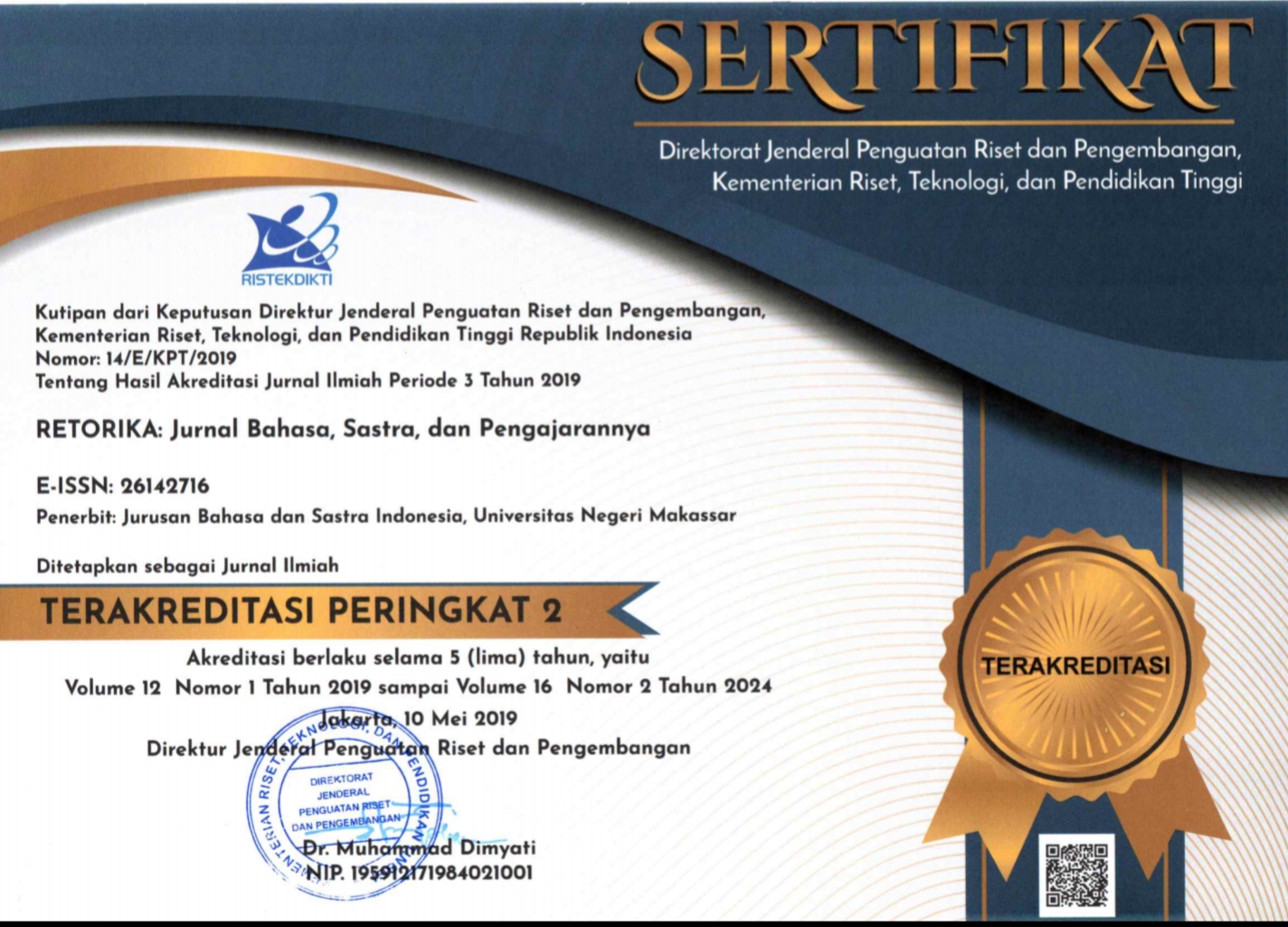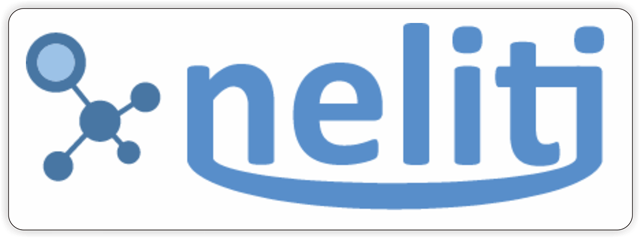TERNATE MALAY LANGUAGE INTERFERENCE IN INDONESIAN LANGUAGE LEARNING PROCESS
(1) Universitas Khaerun Ternate
(2) Universitas Cokroaminoto Palopo
(3) Universitas Khaerun Ternate
(*) Corresponding Author
DOI: https://doi.org/10.26858/retorika.v14i2.23676
Abstract
Ternate Malay Language Interference in the Indonesian Language Learning Process. This research was conducted with the aim of explaining the interference of the Ternate Malay language in the Indonesian language learning process for the eighth-grade students of Banau National Junior High School, Ternate, and describing the factors that cause interference in the learning process of Ternate Malay for eighth-grade students of Banau National Junior High School, Ternate. This study used the descriptive qualitative method. The data used are primary data and secondary data. The data sources were 28 students who spoke Ternate Malay. Data collection techniques, namely: observation, interviews, documentation, and speaking. The data analysis technique uses descriptive qualitative which includes the process of data reduction, data presentation, summarizing, and verification. The results of the data analysis concluded that the form of interference in the Ternate Malay language in the Indonesian language learning process, namely: (1) interference in the form of words, sentences, phrases, and clauses and (2) the factors causing interference in the Indonesian language learning process was caused by: habit, influence opponents of speech, students are more comfortable using Ternate Malay, have not realized or used to use Indonesian in the learning process.
Keywords
Full Text:
PDFReferences
Arifin, W. L. (2011). Interference: its role in the target language mastery to Indonesian learners. Register Journal, 4(1), 91-108.
Ati, A. P., Cleopatra, M., & Widiyarto, S. (2020). Strategi pembelajaran dan pengajaran menulis bahasa Indonesia: Tantangan di era revolusi industri 4.0. Prosiding Samasta.
Chaer, Abdul & Leoni Agustina. 2010. Sosiolinguistik. Jakarta: Rineka Cipta.
Chowdhury, M. K. B. (2020). A Saudi Student Learning English-A Study on L1 Interference and Remedial Teaching. University of Science & Technology Annual.
Derakhshan, A., & Karimi, E. (2015). The interference of first language and second language acquisition. Theory and Practice in language studies, 5(10), 2112-2117.
Effendy, M. H. (2017). Interferensi Gramatikal Bahasa Madura ke dalam Bahasa Indonesia. Dialektika: Jurnal Bahasa, Sastra, dan Pendidikan Bahasa dan Sastra Indonesia, 4(1), 1-19.
Hidayat, R., & Setiawan, T. (2015). Interferensi bahasa Jawa ke dalam bahasa Indonesia pada keterampilan berbicara siswa negeri 1 Pleret, Bantul. LingTera, 2(2), 156-168.
Jannah, L. U. (2016). Interferensi Bahasa Indonesia dalam Pemakaian Bahasa Inggris pada Wacana Tulis Siswa. EDU-KATA, 3(1), 81-86.
Lekova, B. (2010). Language interference and methods of its overcoming in foreign language teaching. Trakia Journal of Sciences, 8(3), 320-324.
Mulyani, Haryanti. 2015. Teori Belajar Bahasa. Tangerang: Pustaka Mandiri.
Pujiono, M., & Nelvita, S. S. (2017). The Lexical Interference of Bataknese Language into Japanese Language amongst Students in Universitas Sumatera Utara. International Journal Of language and Linguistics Vol. 4 No, 4.
Sabbah, S. (2015). Negative transfer: Arabic language interference to learning English. Arab World English Journal (AWEJ) Special Issue on Translation, (4).
Sanmuganathan, K. (2014). Impact of L1 on ESL (English as a Second Language) Writings of the Undergraduates of University of Jaffna. In Proceedings of Jaffna University International Research Conference (JUICE-2012) (pp. 171-181).
Suandi, N. 2014. Sosiolinguistik. Yogyakarta: Graha Ilmu.
Sugiyono. 2015. Metode Penelitian Pendidikan. Bandung.
Susilo, S. V. (2020). Penggunaan Media Pembelajaran Berbasis Audio Visual Untuk Meningkatkan Hasil Belajar Bahasa Indonesia Di Sekolah Dasar. Jurnal Cakrawala Pendas, 6(2).
Wahyuni, S., & Samad, A. G. (2019). Bugis Language Interference with the Use of Indonesian Language in Communicating Students at SMP Negeri 1 Pammana. Journal of Indonesian Language Education and Literary, 4(2), 10-15.
Wahyuningsih, S., & Kaharuddin. (2019). Interferensi bahasa daerah dan bahasa Indonesia terhadap penggunaan bahasa Arab. AL-AF'IDAH: Jurnal Pendidikan Bahasa Arab dan Pengajarannya, 3(2), 90-100.
Zhang, S., Morris, M. W., Cheng, C. Y., & Yap, A. J. (2013). Heritage-culture images disrupt immigrants’ second-language processing through triggering first-language interference. Proceedings of the National Academy of Sciences, 110(28), 11272-11277.
Article Metrics
Abstract view : 273 times | PDF view : 56 timesRefbacks
- There are currently no refbacks.
Copyright (c) 2022 M. Nur Hakim

This work is licensed under a Creative Commons Attribution-NonCommercial 4.0 International License.
Published by:
Department of Indonesian Language, Faculty of Languages and Literature, Universitas Negeri Makassar in cooperate with Asosiasi Dosen Bahasa dan Sastra Indonesia (ADOBSI) and Ikatan Program Studi Pendidikan Bahasa dan Sastra Indonesia (IKAPROBSI).
Address: Department of Indonesian Language Office, DG Building Second Floor, UNM Parangtambung, Daeng Tata Raya Street, Makassar, South Sulawesi, Indonesia
 Email: [email protected]
Email: [email protected]

RETORIKA: Jurnal Bahasa, Sastra,dan Pengajarannya is licensed under a Creative Commons Attribution-NonCommercial 4.0 International License.
















